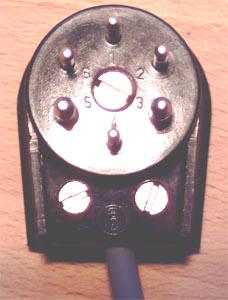Jecklin Float put to test
This site could be interesting for those who are searching for technical information about the Jecklin Float electrostatic headphones. Herr Otto, a owner of some Jecklin Float headphones asked me if it is possible to modify one of my amps so that it can drive a Jecklin Float. So I could not find any technical information in the internet, Herr Otto send me his headphones and driver-boxes for some tests. Here is a list of the components I tested (also see fotos):
headphones:
PS0
PS1
PS2
driver-boxes:
a small PS0-box with two transformers included without label
a bigger PS2-box with four transformers included, labeld Jecklin PS2
result
The PS2-box has a transformation ratio of 1:120. The frequency response is linear between 10 and 5KHz. The amplitude of the left chanel then rises up to 6dB at 15KHz and then decreases rapidly, the other chanel has its peak at already 12KHz. This box delivers a BIAS-Voltage of 1200 Volt.
The PS0-box has a transformation ratio of 1:60. It frequency response is identical in both chanels and is linear between 4KHz and 18KHz. Below 4KHz the amplitude increases slowly until down to 150 Hz and then degreases also slowly until down to 30 Hz. Above 18KHz it rises up to 6dB at 30KHz and then decreases rapidly. The frequenzy response of this box is within 3dB between 30Hz and 18KHz. This box delivers a BIAS-Voltage of -1550 Volt. Normaly, the BIAS-Voltage on the diaphragm is positiv because a negative voltage atracts dust. Driving the headphone with this box can lead to degradation of sound quality because of dust aggregation on the diaphragm. You can correct this fault by changing the polarity of the six diodes on the board.
All values I measured with a PS2 as load. Because of the high internal resistor (ca. 100 Meg) of the BIAS-output I had to use a measuring bridge to measure the BIAS-Voltage.
The measured capacity of the three phones is ca. 300 pF (including cable capacity) with a difference between left and right side of up to 10%.
pin assignment:
 |
If you look at the front of the plug, the pins are, starting from the top clockwise numbered from 1 to 6.
Pin1: BIAS
Pin2: R+
Pin3: R-
Pin4: BIAS
Pin5: L-
Pin6: L+
My impressions by driving the headphones with the driver-boxes:
During listening while using the PS2-box I noticed the missing of resolution and a lack of deep frequencies for all headphones. The high frequencies sound to strong and dirty. The PS0-box sounds significant better, especially in kombination with the PS1, but has an intrusively bass in the range between 100 and 300 Hz. Connected to the PS0 the bass becomes overpowered.
My impressions by driving the headphones with the Sirius amplifier:
The resolution of the headphones increases and they sound more lively. The high frequencies are more accurate. For all three headphones and especially for the PS1 and PS2 I noticed a deficit of frequencies below 100 Hz. This seems to be a weakness of all Jecklin Floats. The testing results of the PS1 and PS2 did not realy awake much enthusiasm. Compared to the driver-boxes, the sound quality has increased but still did sound to colorless.
The more I was surprised when connecting the PS0 to the Sirius. It sounds very agile, with strong and structured basses and accurate in every detail. The sound is very close to the Stax Lambda Nova Signature.
A disadvantage of connecting a Jecklin Float to an amplifier is the limited volume that you can reach. Compared to a Stax a Jecklin Float needs much more signal voltage for a comparable volume.
All headphones I have testet with the reduced BIAS of 1200 Volt from the PS2-box.
Schematic and layout for generating the 1200/1500 volt BIAS-voltage you find here.
Here are som fotos:
The Phones
The PS0-Box
The PS2-Box
More technical infos you find here:
http://www.hifi-wiki.de/index.php/Jecklin_Float_Elektrostat